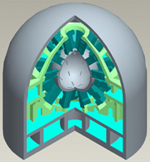University of Wisconsin Neutronics Center of Excellence
The nuclear assessment has traditionally been the strength of the University of
Wisconsin (UW) fusion research program. On the national level, the success of
our nuclear effort led to the recognition of the
UW Fusion Technology Institute (FTI) as the nationwide leader
in the nuclear field. Our nuclear group has developed expertise in the
neutronics, radiation shielding, activation, and radwaste management areas of research.
The numerous publications in these areas reflect our active involvement
in 44 MFE and 26
IFE
projects. During the past two decades, we have led the nuclear task for the
ARIES project,
US-ITER,
ST-FNSF,
NSO/FIRE,
APEX, and numerous IFE
projects.
During the last decade and continuing to the present, the UW neutronics team has overcome a major limitation in the 3-D analysis, allowing fully accurate modeling of complex devices by integrating the CAD geometry directly with the 3-D MCNP code. The newly developed DAGMC and R2S-act codes by the UW Computational Nuclear Engineering Research Group (CNERG) present a unique technology that has been applied successfully to ARIES, ITER and other US fusion studies, preserving all geometrically complex design elements and speeding up feedback and iterations to quickly converge on an acceptable configuration that satisfies the specific design goal, mission, and requirements.
UW FTI personnel have been designing conceptual MFE and IFE power plants and experimental facilities for over 40 years. We collaborated with research teams at national institutions and international organizations and participated in 70 projects. The majority of the research projects are large national design efforts aimed at developing environmentally attractive conceptual designs for future fusion power plants and experimental test facilities. We have been involved in the development of many fusion concepts and developed expertise in both magnetic and inertial confinement concepts that cover a wide range of design approaches, such as tokamaks, spherical tori, stellarators, tandem mirrors, and laser/heavy-ion/Z-pinch driven inertial fusion. Furthermore, we have been involved in several smaller-scale projects focusing on space, advanced D-3He fuel cycle, proliferation-resistance, and non-electric applications.
Specific areas of research and development at the UW-FTI include:
- Neutronics, shielding, and activation analyses
- Environment and radwaste management
- CAD-based neutronics
- ALARA and DKR code development
- Code development
- Medical applications
- Transmutation of fission waste
UW Ph.D. nuclear technology
graduates in neutronics areas occupy key positions in the
U.S. Industry, National Laboratories and Universities.







